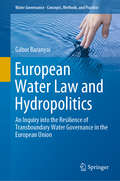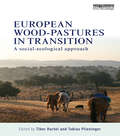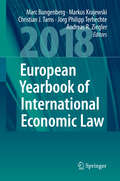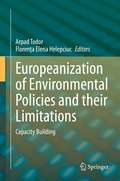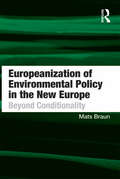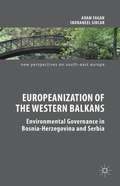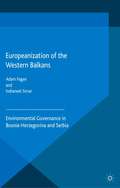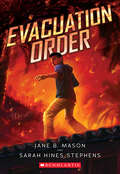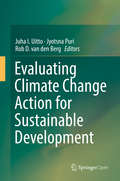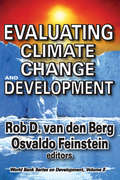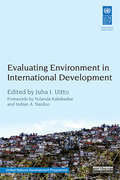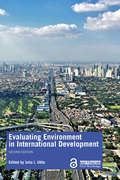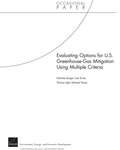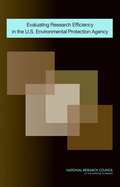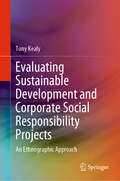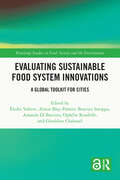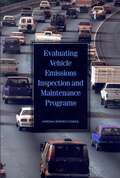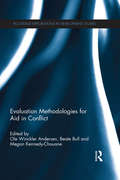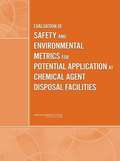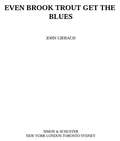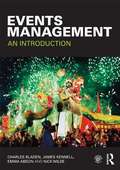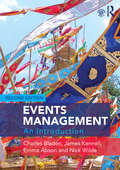- Table View
- List View
European Water Law and Hydropolitics: An Inquiry into the Resilience of Transboundary Water Governance in the European Union (Water Governance - Concepts, Methods, and Practice)
by Gábor BaranyaiThis book provides the first comprehensive assessment of the various issues faced by countries in the European Union, where progressing climate change and urbanization pose significant cooperative challenges in a large number of river basins. Conducting a thorough analysis of the intricate web of EU water governance, it reveals that the hydropolitical stability of the European Union is already at risk. Further, given the structural nature of the shortcomings in EU water policy—e.g. the rigidity of the EU’s founding treaties or the institutional complacency of the European Commission—the book argues that these risks are likely to turn into sources of prolonged conflict, unless EU decision-making bodies take steps to address the new hydrological realities early on.
European Wood-pastures in Transition: A Social-ecological Approach
by Tobias Plieninger Tibor HartelWood-pastures are important elements of European cultural identity and have an exceptional ecological value, yet they are in decline all over Europe. The structure of wood-pastures is strongly influenced by grazing and multiple other land uses and by local and regional environmental conditions. This book examines the diverse expressions of wood-pastures across Europe. It provides a new perspective, using a social-ecological framework to explore social and ecological values, governing institutions, threats and conservation approaches. It explores the major drivers of decline, which are shown to be related to accelerated cultural, institutional and developmental changes occurring across Europe over the past century. Case studies are included from North-Western, Southern, and Eastern Europe. Written by renowned scholars and conservationists, the book contributes to developing better, locally adapted conservation policies and management approaches for wood-pastures.
European Yearbook of International Economic Law 2018 (European Yearbook of International Economic Law #9)
by Markus Krajewski Jörg Philipp Terhechte Marc Bungenberg Andreas R. Ziegler Christian J. TamsVolume 9 of the EYIEL focusses on natural resources law understood as a special area of international economic law. In light of increasing conflicts over access to and the use of natural resources and of their impact on political, social and environmental aspects, the contributions of this volume analyse to which extent international economic law can contribute to the sustainable exploitation, management and distribution of natural resources. The volume collects contributions on general principles of natural resources law, the importance of natural resources for trade, investment and European economic law as well as analyses of particular sectors and areas including fracking, timber, space and deep seabed mining and natural resources in the arctic region.In its section on regional developments, EYIEL 9 addresses two regional integration systems which are usually not at the centre of public interest, but which deserve all the more attention due to their special relations with Europe: The Eurasian Economic Union and the Caribbean Community (CARICOM). Further EYIEL sections address recent WTO and investment case law as well as developments at the IMF. The volume also contains review essays of important recent books in international economic law and other aspects of international law which are connected to international economic relations.The chapter "Sovereignty, Ownership and Consent in Natural Resource Contracts: From Concepts to Practice" by Lorenzo Cotula is open access under a CC BY 4.0 license via link.springer.com.
Europeanization of Environmental Policies and their Limitations: Capacity Building
by Arpad Todor Florenţa Elena HelepciucThis book offers a window into the mechanisms that drive events when countries with poor track records in environmental protection and low administrative capacity, join an organisation with ambitious environmental regulatory regimes, which include some of the highest environmental protections standards in the world.This book examines the institutional building capacity in Romania after two decades of the development of the EU's environmental policy on elaboration, transposition, implementation, monitoring and institutional building. The book examines how Romania has fared as one of the least environmentally friendly EU member states, and poses the following questions. What are the limits of Europeanisation in the area of public policies? What is the reason why, despite the overwhelming public interest in environmental issues, and widespread agreement that urgent action to protect the environment and prevent catastrophic climate change are paramount, the pace of achieving the goals is remains slow. Why do policies fail?This book brings together several case studies focusing on the evolution of environmental policies in Romania over the last twenty years, with a special focus on the post-accession period (2007 onwards). The book provides an analysis of policies, where progress is less than satisfactory, and examines why this is the case.
Europeanization of Environmental Policy in the New Europe: Beyond Conditionality
by Mats BraunPrior to the European Union (EU) 2004/2007 enlargement there were several predictions that this event would hamper progressive decision-making within the EU on environmental policy. It was believed that the new member states had adopted EU rules as a consequence of the EU's conditionality and consequently they would rather slow down the reform speed in the field after accession. In this book, Mats Braun offers an up-to-date account of how post-communist member states have handled policy initiatives in the field of environmental policy after accession. Using detailed case studies of how Bulgaria, the Czech Republic, Poland and Romania dealt with two different EU policy initiatives - REACH and the Climate-Energy Package - he explores whether social norms and the process of socialization can help us understand why the track record of new member states in the area of environmental policy is more varied than was originally envisaged prior to enlargement.
Europeanization of the Western Balkans: Environmental Governance in Bosnia-Herzegovina and Serbia (New Perspectives on South-East Europe)
by Adam Fagan Indraneel SircarEuropeanization of the Western Balkans.
Europeanization of the Western Balkans: Environmental Governance in Bosnia-Herzegovina and Serbia (New Perspectives on South-East Europe)
by Adam Fagan Indraneel SircarThe book analyses the changing roles of international agencies, governmental bodies, non-governmental organisations, and local communities around major road-building environmental impact assessment processes in order to examine whether the influence of the European Union has transformed environmental governance in Bosnia-Herzegovina and in Serbia.
Evacuation Order
by Jane B. Mason Sarah Hines StephensIf you only had a few minutes to evacuate your house in the face of a wildfire, what would you take? And if you were separated from your mom and thought she was in danger, would you still leave - or would you head back in to rescue her?Twelve-year-old Sam lives alone with his mom and their dog in the idyllic seaside town of Santa Bonita. His father died when Sam was young, but his best friend Marco has been helping recreate his dad's old photos as part of a memorial project. One particularly warm October day, however, Sam smells something faint from far away. It's the scent of smoke.An unexpected southern California wildfire is whipping ferociously toward town. Sam, Marco, and the whole neighborhood must urgently evacuate with little warning. Sam is distraught. If his house burns, all his memories of his father will go with it.Even worse, Sam’s dog disappears during the emergency, sending the boy into a panic. When he should be leaving the city with Marco and his family, Sam instead turns back, a decision that will plunge him right into the path of a deadly fire.
Evaluating Climate Change Action for Sustainable Development
by Juha I. Uitto Jyotsna Puri Rob D. van den BergThis book is open access under a Creative Commons license. This authoritative book presents the ever progressing state of the art in evaluating climate change strategies and action. It builds upon a selection of relevant and practical papers and presentations given at the 2nd International Conference on Evaluating Climate Change and Development held in Washington DC in 2014 and includes perspectives from independent evaluations of the major international organisations supporting climate action in developing countries, such as the Global Environment Facility. The first section of the book sets the stage and provides an overview of independent evaluations, carried out by multilateral development banks and development organisations. Important topics include how policies and organisations aim to achieve impact and how this is measured, whether climate change is mainstreamed into other development programs, and whether operations are meeting the urgency of climate change challenges. The following sections focus on evaluation of climate change projects and policies as they link to development, from the perspective of international organisations, NGO's, multilateral and bilateral aid agencies, and academia. The authors share methodologies or approaches used to better understand problems and assess interventions, strategies and policies. They also share challenges encountered, what was done to solve these and lessons learned from evaluations. Collectively, the authors illustrate the importance of evaluation in providing evidence to guide policy change to informed decision-making.
Evaluating Climate Change and Development: Volume 9, World Bank Series on Development (World Bank Series On Evaluation And Development Ser. #Vol. 8)
by Osvaldo N. FeinsteinClimate change has become one of the most important global issues of our time, with far-reaching natural, socio-economic, and political effects. To address climate change and development issues from the perspective of evaluation, an international conference was held in Alexandria, Egypt. This book distills the essence of that timely conference, building on the experiences of more than 400 reports and studies presented.Developing countries may be particularly vulnerable to the expected onslaught of higher temperatures, rising sea levels, changing waterfall patterns, and increasing natural disasters. All societies will have to reduce their vulnerability to these changes, and this book describes how vulnerabilities may be addressed in a systematic manner so that governments and local communities may better understand what is happening. Different approaches are also discussed, including the use of human security as a criterion for evaluation as well as ways to deal with risk and uncertainty. Evaluating Climate Change and Development presents a rich variety of methods to assess adaptation through monitoring and evaluation.The volume deals with climate change, development, and evaluation; challenges and lessons learned from evaluations; mitigation of climate change; adaptation to climate change; vulnerability, risks and climate change; and presents a concluding chapter on the road ahead. Collectively the authors offer a set of approaches and techniques for the monitoring and evaluation of climate change.
Evaluating Environment in International Development
by Juha I. Uitto Yolanda Kakabadse Indran A. NaidooMore than twenty years after the Earth Summit was held in Rio de Janeiro in 1992, both national and international actors in governmental and nongovernmental fields are still searching for insights into how sustainable development can be advanced and environmental concerns incorporated into the development agenda more effectively. Moreover, climate change has emerged as a preeminent challenge to both the environment and to development. Evaluating Environment in International Development provides international perspectives and in-depth knowledge of evaluating development and the environment and applies evaluation knowledge to climate change mitigation and adaptation. The book focuses on the approaches and experiences of leading international organizations, not-for-profits, and multilateral and bilateral aid agencies to illustrate how systematic evaluation is an essential tool for providing evidence for decision-makers. It provides novel and in-depth perspectives on evaluating environment and sustainability issues in developing countries. Moving beyond projects and programmes, it considers aspects such as evaluating normative work on the environment and evaluating environmental consequences of economic and social development efforts. This original collection should be of interest to scholars of environment studies, development studies, international relations, sustainable development and evaluation, as well as practitioners in international organizations and development and environmental NGOs.
Evaluating Environment in International Development
by Juha I. UittoThis book provides novel and in-depth perspectives on evaluating environment and sustainability issues in developing countries. Evaluating Environment in International Development focuses on the approaches and experiences of leading international organizations, not-for-profits, and multilateral and bilateral aid agencies to illustrate how systematic evaluation is an essential tool for providing evidence for decision-makers. Moving beyond projects and programmes, it explores normative work on the environment as well as environmental consequences of economic and social development efforts. This new edition reflects on the 2030 Agenda for Sustainable Development and Sustainable Development Goals and considers how they have influenced efforts in a wide range of countries and what the implications are for evaluation. It also explores ways in which Big Data and geospatial approaches might be utilized. Significantly updated throughout to reflect recent developments in climate change research, and on the implications of the 2020 pandemic, this volume will be of great interest to students and scholars of environment studies, development studies, international relations, sustainable development and evaluation, as well as practitioners in international organizations and development and environmental NGOs.
Evaluating Options for U.S. Greenhouse-Gas Mitigation Using Multiple Criteria
by Michael Toman Thomas Light Nicholas Burger Liisa EcolaChoosing policy responses to mitigate greenhouse gases (GHGs) is one of the great challenges that the United States faces. It will require balancing cost-effectiveness and other objectives that reflect the institutional and political realities of passing major federal legislation with widespread impacts on U.S. producers and consumers. This paper develops a framework for evaluating U.S. GHG-mitigation policy that balances several criteria.
Evaluating Research Efficiency in the U.S. Environmental Protection Agency
by National Research Council of the National AcademiesA new book from the National Research Council recommends changes in how the federal government evaluates the efficiency of research at EPA and other agencies. Assessing efficiency should be considered only one part of gauging a program's quality, relevance, and effectiveness. The efficiency of research processes and that of investments should be evaluated using different approaches. Investment efficiency should examine whether an agency's R&D portfolio, including the budget, is relevant, of high quality, matches the agency's strategic plan. These evaluations require panels of experts. In contrast, process efficiency should focus on "inputs" (the people, funds, and facilities dedicated to research) and "outputs" (the services, grants, publications, monitoring, and new techniques produced by research), as well as their timelines and should be evaluated using quantitative measures. The committee recommends that the efficiency of EPA's research programs be evaluated according to the same standards used at other agencies. To ensure this, OMB should train and oversee its budget examiners so that the PART questionnaire is implemented consistently and equitably across agencies.
Evaluating Sustainable Development and Corporate Social Responsibility Projects: An Ethnographic Approach
by Tony KealyThis book discusses sustainable development decision-making. Focusing on decisions to invest in wind turbine technology as part of a corporation’s CO2 emission reduction strategy, it presents a new evaluation framework, based on the triple bottom line framework widely used by businesses to communicate their adherence to corporate social responsibility. This new framework allows the evaluation of strategic corporate decisions to invest in wind turbines to mitigate global warming in the context of a corporation’s social responsibility, and includes an objective measurement stage to add rigor to the evaluation process. The book describes the use of measured data from wind turbine projects to both develop and validate the methodology, and also identifies key enablers and barriers as businesses attempt to successfully integrate corporate social responsibility into their overall business strategy. Given its scope, the book appeals to postgraduate students, researchers, and business professionals interested in the environmental impact of corporations. Featuring case studies from Ireland, it is particularly relevant to audiences within Europe.
Evaluating Sustainable Food System Innovations: A Global Toolkit for Cities (Routledge Studies in Food, Society and the Environment)
by Alison Blay-Palmer Élodie Valette Amanda Di Battista Beatrice Intoppa Ophélie Roudelle Géraldine ChaboudThis book presents URBAL, an approach that applies impact pathway mapping to understand how food system innovations in cities, and their territories, change and impact food system sustainability. Around the world, people are finding innovative ways to make their food systems more sustainable. However, documenting and understanding how these innovations impact the sustainability of food system can be a challenge. The Urban Driven Innovations for Sustainable Food Systems (URBAL) methodology responds to these constraints by providing innovations with a simple, open-source, resource-efficient tool that is easily appropriated and adaptable to different contexts. URBAL is designed to respond to the demands of field stakeholders, whether public or private, to accompany and guide them in their actions and decision-making with regard to sustainability objectives. This book presents this qualitative and participatory impact assessment method of food innovations and applies it to several cases of food innovation around the world, including the impact of agricultural districts in Milan, chefs and gastronomy in Brasilia, e-commerce in Vietnam, eco-friendly farm systems in Berlin and The Nourish to Flourish governance process in Cape Town. The book demonstrates how food innovations can impact different dimensions of sustainability, positively and negatively, and identify the elements that facilitate or hinder these impacts. The volume reflects on how to strengthen the capacity of these stakeholders to disseminate their innovations on other scales to contribute to the transition towards more sustainable food systems. This book will be of great interest to students and scholars working on sustainable food systems, urban food, food innovation and impact assessment, as well as policymakers, practitioners and funders interested in these areas.
Evaluating Vehicle Emissions Inspection and Maintenance Programs
by Committee on Vehicle Emission Inspection Maintenance ProgramsEmissions inspection and maintenance (I/M) programs subject vehicles to periodic inspections of their emission control systems. Despite widespread use of these programs in air-quality management, policy makers and the public have found a number of problems associated with them. Prominent among these issues is the perception that emissions benefits and other impacts of I/M programs have not been evaluated adequately. Evaluating Vehicle Emissions Inspection and Maintenance Programsassesses the effectiveness of these programs for reducing mobile source emissions. In this report, the committee evaluates the differences in the characteristics of motor vehicle emissions in areas with and without I/M programs, identifies criteria and methodologies for their evaluation, and recommends improvements to the programs. Most useful of all, this book will help summarize the observed benefits of these programs and how they can be redirected in the future to increase their effectiveness.
Evaluation Methodologies for Aid in Conflict (Routledge Explorations in Development Studies)
by Ole Winckler Andersen Beate Bull Megan Kennedy-ChouaneKnowledge and rigorous evidence around the role of external development partners in situations of conflict and fragility is still lacking. There is little accountability for the billions in aid being spent in places like Afghanistan, Iraq and the Democratic Republic of Congo. This book analyses evaluation theory and practice in order to help fill this knowledge gap and advocates a realistic and rigorous approach to evaluating international engagement. Through a series of case studies, this book highlights both the promise, and potential pitfalls, of taking a more evaluative approach to understanding aid in conflict regions. These illustrate the methodological and analytical approach taken by researchers working to understand the results and effectiveness of conflict prevention and peacebuilding support. While well-grounded in current theoretical and methodological debates, the book provides valuable practical information by examining how and why different choices were made in the context of each evaluation. The book shows what future steps may be envisaged to further strengthen evaluations of support for conflict prevention and peacebuilding. The analysis draws on a wealth of perspectives and voices to provide researchers and students in development studies and conflict and peace studies as well as development evaluators with a deep and broad understanding of evaluation methods and approaches.
Evaluation of Safety and Environmental Metrics for Potential Application at Chemical Agent Disposal Facilities
by National Research Council of the National AcademiesBy the end of 2009, more than 60 percent of the global chemical weapons stockpile declared by signatories to the Chemical Weapons Convention will have been destroyed, and of the 184 signatories, only three countries will possess chemical weapons-the United States, Russia, and Libya. In the United States, destruction of the chemical weapons stockpile began in 1990, when Congress mandated that the Army and its contractors destroy the stockpile while ensuring maximum safety for workers, the public, and the environment. The destruction program has proceeded without serious exposure of any worker or member of the public to chemical agents, and risk to the public from a storage incident involving the aging stockpile has been reduced by more than 90 percent from what it was at the time destruction began on Johnston Island and in the continental United States. At this time, safety at chemical agent disposal facilities is far better than the national average for all industries. Even so, the Army and its contractors are desirous of further improvement. To this end, the Chemical Materials Agency (CMA) asked the NRC to assist by reviewing CMA's existing safety and environmental metrics and making recommendations on which additional metrics might be developed to further improve its safety and environmental programs.
Evaluation of the U.S. Department of Energy's: Alternatives for the Removal and Disposition of Molten Salt Reactor Experiment Fluoride Salts
by Molten Salt Panel of the Committee on Remediation of Buried Tank WastesThis book discusses the technical alternatives for cleanup of radioactive fluoride salts that were the fuel for the Molten Salt Reactor Experiment, a novel nuclear reactor design that was tested in the 1960s at the Oak Ridge National Laboratory in Tennessee. These fluoride salts pose an unusual cleanup challenge. The book discusses alternatives for processing and removing the salts based on present knowledge of fluoride salt chemistry and nuclear reactions of the radioactive constituents.
Eve (Adapted for Young Adults): How the Female Body Shaped Human Evolution
by Cat BohannonThe groundbreaking New York Times bestseller is now adapted for young adults! This is the 200-million-year story of how the female body gave rise to the human species and forever shaped life on Earth and what that means for us in the future.Why do women live longer than men? Why do girls score better at every academic subject than boys until puberty, when suddenly their scores plummet? Is the female brain "wired differently?" These questions and common debates around scientific claims are thoughtfully examined in this adaptation perfect for young people.This brand-new adaptation is a friendly, funny, and engaging read. It explores teen related topics such as mental health and the biology behind it, including insights on how adolescent brains are going through all kinds of changes, and shifting hormones. Author Cat Bohannon explains the roots of sexism and shows how, though it may have even served some evolutionary purpose long ago, it no longer serves us today, and it&’s high time we leave it in the past.Filled with amazing stories of both past and present, Eve will delight any young reader looking to understand the body—its amazing history, its wondrous capability, its oddities and mysteries, and its relevance to so many issues captivating contemporary thought and discussion.
Even Brook Trout Get The Blues
by John GierachFrom his reminiscences about learning to fish to a lyrical piece about fishing during a late spring snow to a wry, though compassionate, look at the hard life of a brook trout, Gierach provides entertainment for fly-fishers and literature lovers alike.
Even So
by Charles Boardman HawesCharles Boardman Hawes is the Newberry Medal award-winning author of 'The Dark Frigate'. "Donald Hastings followed the sea. Holiest, impetuous, young, as were so many of those sea captains in that golden era of the early nineteenth century, he left but one shadow on his memory—perhaps not altogether a shadow. Therein lies the story.
Events Management
by Emma Abson Nick Wilde James Kennell Charles BladenContemporary events management is a diverse and challenging field. This major new introductory textbook is the first to fully explore the multi-disciplinary nature of events management and to provide all the practical skills and professional knowledge students need to succeed in the events industry. The book covers every type of event studied on an Events Management course, including sports, music, the arts, corporate events, tourism, and the public and voluntary sectors. It introduces the key issues facing the contemporary events industry, from health, safety and risk management to sustainability to developing a market-oriented business, with every topic brought to life through case-studies, personal biographies and examples of best practice. Written by a team of authors with many years of industry experience, it introduces the practical skills required in every core area of events management, including marketing, finance, project management, strategy, operations, event design and human resources. A companion website for the book includes a dazzling array of additional features, including self-test questions, audio interviews with key industry figures, additional case-studies and PowerPoint slides for each chapter. Events Management: An Introduction is the essential course text for any events management program.
Events Management: An Introduction
by Emma Abson Nick Wilde James Kennell Charles BladenContemporary events management is a diverse and challenging field. This introductory textbook fully explores the multidisciplinary nature of events management and provides the student with all the practical skills and professional knowledge they need in order to succeed in the events industry. It introduces every core functional area of events management, such as marketing, finance, project management, strategy, operations, event design and human resources, in a vast array of different event settings from sport to political events. This new edition has been updated to include: • New and updated content on developments in technology, risk management and event volunteering. • New and updated case studies that include emerging economies. • New industry voices by international practitioners. Every topic is brought to life through vivid case studies, personal biographies and examples of best practice from the real world of events management. Written by a team of authors with many years’ experience of working in the events industry, Events Management: An Introduction is the essential course text for any events management programme.
